Related Research Articles

Bare-knuckle boxing is a full-contact combat sport based on punching without any form of padding on the hands. The sport as it is known today originated in 17th-century England and differs from street fighting as it follows an accepted set of rules.
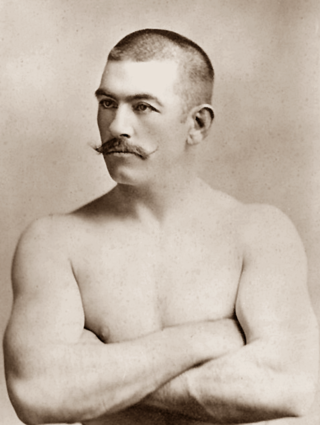
John Lawrence Sullivan, known simply as John L. among his admirers, and dubbed the "Boston Strong Boy" by the press, was an American boxer. He is recognized as the first heavyweight champion of gloved boxing, de facto reigning from February 7, 1882, to September 7, 1892. He is also generally recognized as the last heavyweight champion of bare-knuckle boxing under the London Prize Ring Rules, being a cultural icon of the late 19th century America, arguably the first boxing superstar and one of the world's highest-paid athletes of his era. Newspapers' coverage of his career, with the latest accounts of his championship fights often appearing in the headlines, and as cover stories, gave birth to sports journalism in the United States and set the pattern internationally for covering boxing events in media, and photodocumenting the prizefights.

Thomas Molineaux, sometimes spelled Molyneaux or Molyneux, was an American bare-knuckle boxer and possibly a former slave. He spent much of his career in the United Kingdom of Great Britain and Ireland, where he had notable successes. He arrived in England in 1809 and started his fighting career there in 1810. His two fights against Tom Cribb, widely viewed as the Champion of England, brought Molineaux fame even though he lost both contests. The result of the first encounter was hotly contested, with accusations of a fix. The second match with Cribb, however, was an undisputed loss. His prizefighting career ended in 1815. After a tour that took him to Scotland and Ireland, he died in Galway, Ireland, in 1818 at age 34.

James "Jem" Mace was an English boxing champion, primarily during the bare-knuckle era. He was born at Beeston, Norfolk. Although nicknamed "The Gypsy", he denied Romani ethnicity in his autobiography. Fighting in England, at the height of his career between 1860 and 1866, he won the English Welterweight, Heavyweight, and Middleweight Championships and was considered one of the most scientific boxers of the era. Most impressively, he held the World Heavyweight Championship from 1870 to 1871 while fighting in the United States.

John Morrissey, also known as Old Smoke, was an Irish American politician, bare-knuckle boxing champion, and criminal.
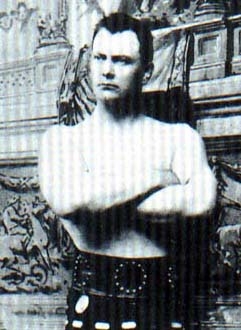
William Muldoon was an American Greco-Roman Wrestling champion, a physical culturist, and the first chairman of the New York State Athletic Commission. He once wrestled a match that lasted over seven hours.

Patrick Ryan was an Irish American boxer, and became the bare-knuckle American heavyweight champion on 30 May 1880, after he won the title from Joe Goss. He retained the title until losing it to the exceptional John L. Sullivan on 7 February 1882.

William Perry, known as "The Tipton Slasher" after his native town of Tipton, was a British heavyweight prize fighter of the 19th century and claimed the championship of England, with some dispute, for two periods between 1850 and 1857. His fighting career began in London in 1835 and after fighting a number of highly rated championship contenders, he first claimed the English heavyweight championship by defeating Tom Paddock in twenty-seven rounds on 17 December 1850.
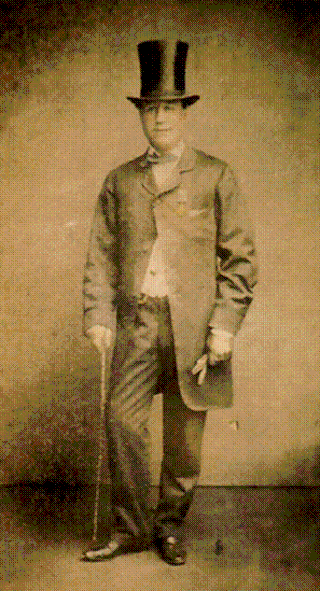
Tom Sayers was an English bare-knuckle prize fighter. There were no formal weight divisions at the time, and although Sayers was only five feet eight inches tall and never weighed much more than 150 pounds, he frequently fought much bigger men. In a career which lasted from 1849 until 1860, he lost only one of sixteen bouts. He was recognized as heavyweight champion of England between 1857, when he defeated William Perry and his retirement in 1860.

Nat Langham was an English middleweight bare-knuckle prize fighter. He had the distinction of being the only person ever to beat Thomas Sayers while defending the English middleweight championship. Langham first took the championship by defeating George Gutteridge on 23 November 1846. Langham was considered a scientific boxer, and known for using sharp, well-timed blows, particularly with his left, though he was right handed. He was a 1992 inductee into the International Boxing Hall of Fame and a mentor to the British boxers Tom King and Jem Mace.

Tom King also known as "The Fighting Sailor" was an English boxer who fought both bare-knuckle and with gloves. Strong, fast, and durable he was a skilled pugilist. One of his quirkier pre-fight rituals was to drink a tot of gin before every bout. He retired from the ring in 1863, as the Heavyweight Champion of England, following his defeat of the reigning champion Jem Mace and American contender John C. Heenan.
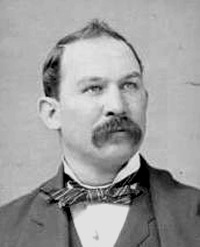
Joseph Goss (1837-1885) was an English bare knuckle boxer. He emigranted to the United States of America in 1867. After defeating Tom Allen in Boone County, Kentucky, he held the American and what many boxing historians now consider the World Heavyweight boxing championship from 7 September 1876 to 30 May 1880. Although he rarely scaled more than 160 pounds, the clever and aggressive Goss routinely fought men both bigger and heavier than himself.
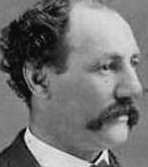
Joe Coburn was an Irish-American boxer. In 1862 he claimed the Heavyweight Championship from John Carmel Heenan when Heenan refused to fight him.

Charles Watson Mitchell was an English world heavyweight boxing title contender and lightweight champion.
Dick Curtis was an English bare-knuckle boxer who was considered the best and most powerful English lightweight of his era. He had only one loss in his career and was inducted into the International Boxing Hall of Fame in 2006.

Pedlar Palmer, born Thomas Palmer, was an English boxer who held the world bantamweight championship from 1895 to 1899.

Pat O'Keeffe, was a professional English boxer who became the British champion in both the welterweight and middleweight weight classes. His professional career spanned the years between 1902 and 1918. In 1914 he made an unsuccessful bid for the European heavyweight belt, losing to Georges Carpentier. Between 1907 and 1910 he left Britain and continued his boxing career in the United States, and then Australia. On the outbreak of World War I he joined the British Army to work as a Physical Training Instructor (PTI) and Recruiting Sergeant for the 1st Surrey Rifles. He won the Lonsdale Belt outright when he defeated Bandsman Blake at the National Sporting Club (N.S.C) on 28 January 1918, becoming British Middleweight Champion.
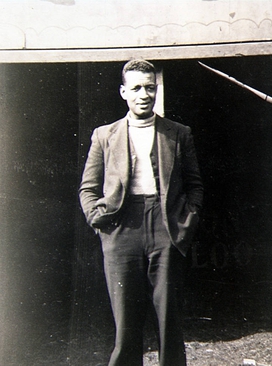
Leonard Benker Johnson, known simply as Len among his admirers, and dubbed "Len Johnson" by the press, was a British boxer who competed from 1920 to 1933. He held the British Empire middleweight title, the first non-white boxer to hold a major title during the British colour bar era, de facto reigning from 20 February 1926 to 12 July 1926. He also held the Northern Area championships at middleweight and light-heavyweight, respectively. A strategic and intelligent boxer, Johnson was considered to be one of the best middleweights of his era. He was known for his exceptional boxing skill, using an educated left-hand, as well a slippery defence that made him difficult to hit, while leaving his features largely unmarked throughout his thirteen-year career. Additionally, Johnson possessed a very long reach and rather good height.
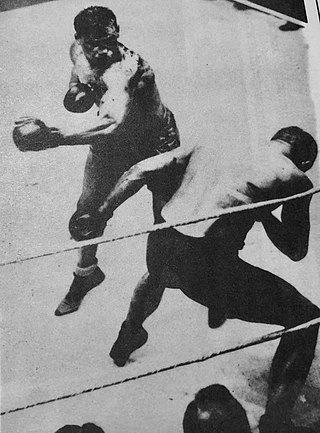
Jim Sullivan was a British boxer who was British middleweight champion between 1910 and 1912. He went on to challenge for the European title.
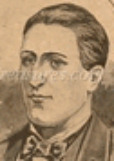
Henry Alfred Broome was a boxer from the bare-knuckle fighting era who became heavyweight champion of England in September, 1851 when he defeated fellow Englishman William Perry in Mildenhall, England. He lost the title in May, 1856 to Tom Paddock in Suffolk.
References
- 1 2 3 "Great Fight in America between Tug Wilson and Sullivan". Leicester Daily Mercury. 19 July 1882.
- ↑ Anderson, Jack (November 2001). "Pugilistic Prosecutions: Prize Fighting and the Courts in Nineteenth Century Britain". The Sports Historian. 21 (2): 35–53. doi:10.1080/17460260109447881.
- ↑ "Police Intelligence". Leicester Mail. 29 December 1866.
- ↑ "Sharp and Merry Mill near Sheffield". Bell's Life in London and Sporting Chronicle. 21 July 1866.
- ↑ "The Aylestone Prize Fight". Leicester Chronicle. 19 October 1878.
- 1 2 "Sporting Notes". Weekly Dispatch. 23 July 1882.
- 1 2 "American Sporting Notes". Sporting Life. 3 August 1882.
- ↑ "The Ring in America". Sporting Life. 31 August 1882.
- ↑ "Tug Wilson and Mitchell". Sporting Life. 13 February 1883.
- ↑ "Sporting Fancies". The Umpire. 6 September 1885.
- ↑ "Assault at Arms at Leicester". Sporting Life. 15 April 1886.
- ↑ "A few words with J.L. Sullivan". Sheffield Evening Telegraph. 25 November 1887.
- ↑ "Leicester 'Sportsmen' at loggerheads: 'Tug Wilson' gives a 'Demonstration'". Leicester Chronicle. 28 November 1891.
- ↑ "'Tug' Wilson: Death of Boxer who met Sullivan". Hull Daily Mail. 1 February 1933.
- ↑ "Funeral of "Tug" Wilson". Nottingham Evening Post. 4 February 1933.
- ↑ "'Tug' Wilson's Widow Dies". Leicester Chronicle. 7 July 1934.
- ↑ Bradford, Edward Eden (1923). Life of Admiral of the fleet Sir Arthur Knyvet Wilson, bart. London: John Murray. p. 224.
- ↑ Partridge, Eric (1949). A Dictionary Of Slang And Unconventional English (3rd ed.). p. 560.